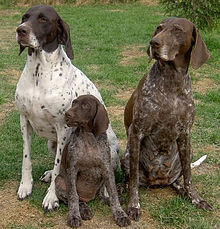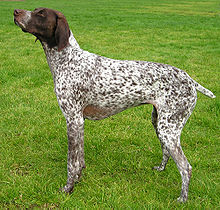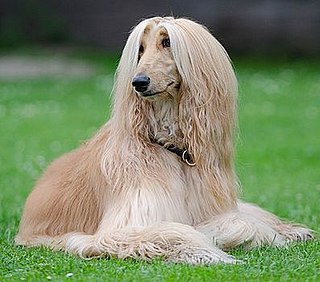
The Afghan Hound is a hound distinguished by its thick, fine, silky coat, and a tail with a ring curl at the end. The breed originates in the cold mountains of Afghanistan. Its local name is Sag-e Tāzī or Tāžī Spay. Other names for this breed are Tāzī, Balkh Hound, Baluchi Hound, and Barakzai Hound.

The Pudelpointer is a versatile hunting dog breed from Germany. It is a pointing breed that came from a cross between the German hunting poodle (pudel) and the English Pointer.

The Labrador Retriever or simply Labrador is a British breed of retriever gun dog. It was developed in the United Kingdom from St. John's water dogs imported from the colony of Newfoundland, and was named after the Labrador region of that colony. It is among the most commonly kept dogs in several countries, particularly in the European world.

The American Eskimo Dog is a breed of companion dog, originating in Germany. The American Eskimo Dog is a member of the Spitz family. The breed's progenitors were German Spitz, but due to anti-German sentiment during the First World War, it was renamed "American Eskimo Dog." Although modern American Eskimo Dogs have been exported as German Spitz Gross, the breeds have diverged and the standards are significantly different. In addition to serving as a watchdog and companion, the American Eskimo Dog also achieved a high degree of popularity in the United States in the 1930s and 1940s as a circus performer.

The Airedale Terrier, also called Bingley Terrier and Waterside Terrier, is a dog breed of the terrier type that originated in the valley (dale) of the River Aire, in the West Riding of Yorkshire, England. It is traditionally called the "King of Terriers" because it is the largest of the terrier breeds. The Airedale was bred from the Old English Black and Tan Terrier and the Otterhound and probably some other Terrier breeds, and has contributed to other dog breeds, such as the Yorkshire Terrier.

The Vizsla, also known as Hungarian Vizsla, Magyar Vizsla or Hungarian Pointer, is a dog breed from Hungary and belongs to the Fédération Cynologique Internationale (FCI) group 7, the Canadian Kennel Club (CKC) group 1, and the American Kennel Club. The Hungarian or Magyar Vizsla or Smooth-Haired Vizsla are sporting dogs and loyal companions. The Vizsla's medium size is one of the breed's most appealing characteristics. As a hunter of fowl and upland game, the Vizsla has held a prominent position among sporting dogs – that of household companion and family dog.
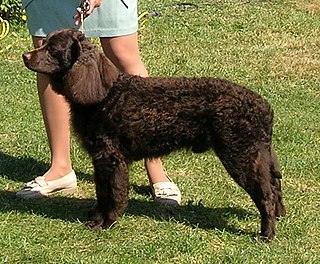
The American Water Spaniel is a breed of spaniel which originated in the United States. It was developed in the state of Wisconsin during the 19th century from a number of other breeds, including the Irish and English Water Spaniels. The breed was saved by Dr. Fred J. Pfeifer, who set up the breed club and standard, and whose work led to recognition for the breed by the United Kennel Club, and later, the American Kennel Club. While they are the state dog of Wisconsin, they remain a rare breed.
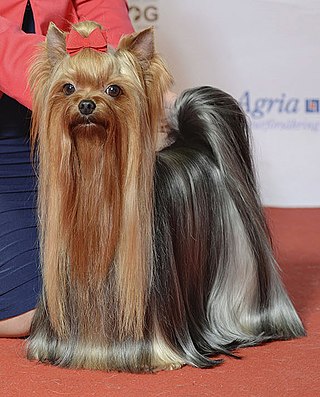
The Yorkshire Terrier, also known as a Yorkie, is a British breed of toy dog of terrier type. It is among the smallest of the terriers and indeed of all dog breeds, with a weight of no more than 3.2 kg (7 lb). It originated in the nineteenth century in the English county of Yorkshire, after which it is named. The coat is tan on the head and dark steel-grey on the body; no other colour is accepted by either The Kennel Club or the Fédération Cynologique Internationale.

The German Wirehaired Pointer is a medium to large-sized griffon type breed of dog developed in the 19th century in Germany for versatile hunting. It became a leading gun dog in Germany in the later part of the 20th century. It is the result of the careful mixing and crossing of the Wirehaired Pointing Griffon, German Shorthaired Pointer, German Roughhaired Pointer, and the hunting Pudelpointer in the late 19th century.
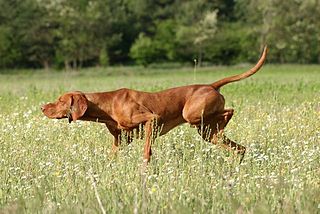
Pointing dogs, sometimes called bird dogs, are a type of gundog typically used in finding game. Gundogs are traditionally divided into three classes: retrievers, flushing dogs, and pointing breeds. The name pointer comes from the dog's instinct to point, by stopping and aiming its muzzle towards game. This demonstrates to the hunter the location of their quarry and allows them to move into gun range. Pointers were selectively bred from dogs who had abundant pointing and backing instinct. They typically start to acquire their hunting instincts at about 2 months of age.

The Miniature Pinscher, also known as the Zwergpinscher and Mini Pin, is a small breed of dog of the pinscher type originating in Germany. While the breed's visual similarities to the Toy Manchester Terrier, which somewhat resembles the Pinscher breeds, remain a matter of controversy, genetic research has shown that the two breeds have shared, unique ancestry. The ancestors of the Toy Manchester and Miniature Pinscher may have become geographically separated many centuries ago and retained similarities simply through breeding selection for the same traits; nevertheless, the 2017 research also showed that the two breeds remain more closely related to each other than to other breeds. The breed's ancestors may also include the German Pinscher, Italian greyhounds and dachshunds. The Miniature Pinscher's known origins are in Germany, where it was often referred to as the Zwerg Pinscher in historical documents. German Kennel Club documents also refer to the Miniature Pinscher as the "reh" Pinscher, but this term is only used for a dog of stag-red color, "reh" referring to a small red deer formerly found in German forests. The Miniature Pinscher originated several centuries ago as an efficient barnyard ratter.

The Boykin Spaniel is a medium-sized breed of dog, a Spaniel bred for hunting wild turkeys and ducks in the Wateree River Swamp of South Carolina, in the United States. It is the state dog of South Carolina, where it was discovered and further developed by hunters in the early through mid 1900s. September 1 is Boykin Spaniel Day in South Carolina, originally established in 1984.

The German Longhaired Pointer (GLP) is a breed of dog. Developed in Germany, it is used as a multipurpose gundog. It is closely related to its cousins, the German Shorthaired Pointer (GSP), the German Wirehaired Pointer (GWP) and the Large Münsterländer, which was previously part of the breed.

The French Spaniel is a breed of dog of the Spaniel-like setter. It was developed in France and Canada as a hunting dog, descended from dogs of the 14th century. Popular with royalty during the Middle Ages, it nearly became extinct by the turn of the 20th century but was saved by the efforts of Father Fournier, a French priest. One of the largest breeds of Spaniel, it typically has a white coat with brown markings. It is a friendly breed that has few health issues, but can be affected by a syndrome called acral mutilation and analgesia. The breed is recognised by Canadian and international kennel clubs but not by The Kennel Club (UK). The American Kennel Club has included the breed in its Foundation Stock Service, the first step to full recognition.
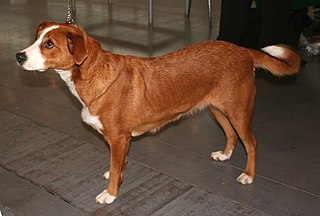
The Austrian Pinscher is a medium-sized breed of pinscher-type dog from Austria, where dogs of the type were originally farm dogs, keeping barns free of rats and acting as home guards, livestock guardians, and drovers. The name originally given to the breed in 1928 was the Österreichischer Kurzhaarpinscher to differentiate it from similarly named breeds, but today in its country of origin the breed is officially called the Österreichischer Pinscher, or Austrian Pinscher in English.

The Braque d'Auvergne is a breed of dog originating in the mountain area of Cantal, in the historic Auvergne province in the mid-south of France. It is a pointer and versatile gundog. The breed descends from ancient regional types of hunting dogs.

The Ariège Pointer is a French breed of hunting dog of pointer type. It originates in the Ariège département of Occitanie, in south-western France. The breed name may be rendered in English as Ariège Pointing Dog or Braque de l'Ariège.

The Braques Français are hunting dogs, from a very old type of gun dog used for pointing the location of game birds for a hunter. There are two breeds of Braque Français, both from the south of France, the Braque français, type Gascogne and the Braque français, type Pyrénées They are popular hunting dogs in France, but are seldom seen elsewhere.

The Hungarian Wirehaired Vizsla is a Hungarian breed of pointer dog. The Hungarian name, Drótszőrű magyar vizsla, is translated as Hungarian Wirehaired Pointer.

The Dalmatian is a breed of dog with a white coat marked with dark-coloured spots. Originally bred as a hunting dog, it was also used as a carriage dog in its early days. The origins of this breed can be traced back to present-day Croatia and its historical region of Dalmatia. It is thought that early ancestors of the breed were certain breeds of pointers and a spotted Great Dane. Today, it is a popular pet and many enthusiasts enter Dalmatians into kennel club competitions.

